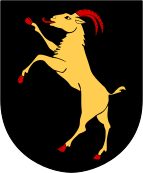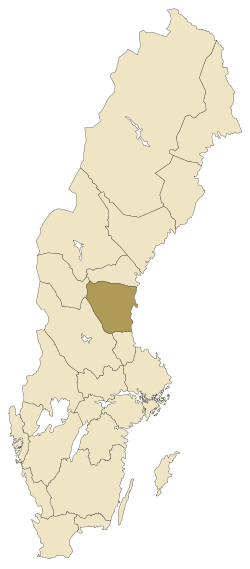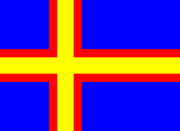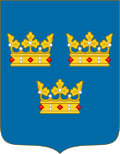Hälsingland
Hälsingland (Swedish pronunciation: [ˈhɛ̌lːsɪŋland] (![]()
Hälsingland | |
|---|---|
 Coat of arms | |
 | |
| Country | Sweden |
| Land | Norrland |
| Counties | Gävleborg County Jämtland County Västernorrland County |
| Area | |
| • Total | 14,264 km2 (5,507 sq mi) |
| Population (2016)[1] | |
| • Total | 131,373 |
| • Density | 9.2/km2 (24/sq mi) |
| Ethnicity | |
| • Language | Swedish |
| Culture | |
| • Flower | Flax |
| • Animal | Lynx |
| • Bird | Ural owl |
| • Fish | Ide |
| Time zone | UTC+1 (CET) |
| • Summer (DST) | UTC+2 (CEST) |
Administration
The traditional provinces of Sweden serve no administrative or political purpose, but are historical and cultural entities. In the case of Hälsingland the province constitutes the northern part of the län ('administrative county') Gävleborg County. Minor parts of the province are in Jämtland County and in Västernorrland County.
The following municipalities have their seats in Hälsingland:
Heraldry

The coat of arms were granted in 1560 in the era of King Gustav Vasa. At that time, Hälsingland was known for its large scale goat breeding, and the arms depicted a standing goat facing heraldic right (blazon: Sable, a Goat rampant Or attired and hoofed Gules). This, combined with the arms of Gästrikland, forms the coat of arms for Gävleborg County.
Geography
The terrain is mostly mountainous and rocky, sloping down towards the coast. The highest elevation in the northern part is 530 meters, and 600 meters in the western part. Approximately 85% of the land area is covered with forest, and the timber industry has historically been the main source of income. Apart from some areas around the river systems, notably around the River Ljusnan, the soil is barren. Large areas consist of rocks and bogs and are unsuitable for agriculture.
A notable geological feature is the Dellen lake system, created from flooded meteoric impact craters. It is the only occurrence in Sweden of the volcanic Andesite rock, to which it has given the name dellenite.
History
The earliest mention of the people of Hälsingland may be in the Old English poem Widsith, from the 9th or 10th century, where a people called the Hælsings are referred to. The first definite mention of the people is made by Adam of Bremen around 1070, in reference to the leidang shipping fleet.
In the medieval age, the "Helsings" were the Swedish speaking inhabitants of the entire coastal region north of Uppland, a rather imprecise denomination. In the early provincial law of Uppland, the border between northern Uppland and Hälsingland was the Ödmården forest.
In the 13th century a large number of people emigrated from Hälsingland to the southern coasts of Finland, then called Österland. They named places after Hälsingland, most notably the river Helsingeå and its first rapids Helsingfors. In 1550 the latter gave name to a new town founded next to it by King Gustav Vasa. In 1812 the city of Helsinki became capital of Finland.
The oldest city in Hälsingland is Hudiksvall, chartered in 1582. After that, Söderhamn was chartered in 1620. In 1942 Hälsingland was granted its third city, Bollnäs, which was to become the last city (in Hälsingland) as City status in Sweden was abolished in 1971.
The town of Hudiksvall, one of the oldest in Norrland, was ransacked by Russian troops in 1721. Hälsinge Regiment was the provincial regiment.
Elections
Hälsingland is part of the Gävleborg constituency for national elections. This list covers the six municipalities that have their seats in Hälsingland, since the municipal reform before the 1973 election.
Riksdag
| Year | % | Votes | V | S | MP | C | L | KD | M | SD | NyD | Other |
|---|---|---|---|---|---|---|---|---|---|---|---|---|
| 1973[2] | 89.6 | 93,853 | 9.1 | 45.5 | 31.2 | 6.3 | 1.8 | 5.7 | 0.5 | |||
| 1976[3] | 90.2 | 97,764 | 7.0 | 46.4 | 31.8 | 7.0 | 1.4 | 6.0 | 0.4 | |||
| 1979[4] | 89.2 | 97,152 | 7.3 | 48.1 | 26.5 | 6.9 | 1.7 | 8.9 | 0.6 | |||
| 1982[5] | 90.0 | 98,734 | 7.2 | 50.3 | 2.0 | 22.2 | 4.1 | 2.1 | 11.8 | 0.2 | ||
| 1985[6] | 87.8 | 96,637 | 6.9 | 50.4 | 1.8 | 19.0 | 10.4 | 11.3 | 0.1 | |||
| 1988[7] | 83.6 | 90,823 | 7.4 | 48.8 | 5.4 | 18.0 | 8.6 | 3.3 | 8.1 | 0.4 | ||
| 1991[8] | 84.3 | 91,410 | 6.1 | 43.5 | 3.7 | 15.3 | 6.8 | 7.1 | 11.3 | 5.8 | 0.4 | |
| 1994[9] | 84.3 | 91,066 | 8.3 | 50.9 | 6.2 | 12.8 | 4.8 | 3.7 | 11.5 | 1.0 | 0.7 | |
| 1998[10] | 78.3 | 82,026 | 17.1 | 39.9 | 5.6 | 10.2 | 3.0 | 10.4 | 11.9 | 2.0 | ||
| 2002[11] | 76.6 | 78,506 | 11.4 | 41.0 | 4.6 | 15.9 | 8.8 | 8.0 | 8.2 | 0.7 | 1.4 | |
| 2006[12] | 77.8 | 78,449 | 7.7 | 40.0 | 4.0 | 15.8 | 4.2 | 5.7 | 16.5 | 2.9 | 3.1 | |
| 2010[13] | 81.1 | 81,954 | 7.0 | 38.4 | 5.6 | 9.9 | 4.4 | 4.6 | 21.4 | 7.1 | 1.5 | |
| 2014[14] | 84.3 | 84,494 | 6.0 | 39.1 | 4.7 | 8.9 | 2.9 | 3.5 | 15.9 | 16.1 | 3.0 | |
| 2018[15] | 85.3 | 84,442 | 8.0 | 34.6 | 2.7 | 12.1 | 3.0 | 5.9 | 13.8 | 18.6 | 1.3 |
Culture
Dialect
The local dialect is known as Hälsingemål or Hälsingska but has no official linguistic recognition.
Folk architecture
The magnificent Decorated Farmhouses of Hälsingland—"Hälsingegårdar"—are a UNESCO World Heritage Site. Two or even three storeys high, the farmhouses are built to show wealth and independence, and much inventiveness has gone into decorating their interiors, which combine aristocratic fashions with traditional materials and techniques.
Sports
Bandy is very popular in Hälsingland; it is the only district where bandy is bigger than ice hockey.
Football in the province is administered by Hälsinglands Fotbollförbund.
Notable natives
- Tomas Brolin former football player, who played in the World Cup All Star Team 1994, was born in Finflo outside the town of Hudiksvall.
- Hans Johansson, former bandy player, several times Swedish and world champion, is originally from Edsbyn.
- Photographer and author Hilding Mickelsson, who spent his life documenting and preserving Hälsingland's cultural, intangible and natural heritage.
- Actress Noomi Rapace, famous through the adaptions of the Millennium series, was born in Norrbo, Hudiksvall.
- Marie Richardson, an actress appearing in over a hundred productions on the stage, television and film, was born in the town of Ljusdal.
- Archbishop Nathan Söderblom, Nobel Peace Prize laureate in 1930, was born in Trönö, Hälsingland in 1866.
Subdivisions
Hälsingland was historically divided into districts:
- Arbrå Court District
- Bergsjö Court District
- Delsbo Court District
- Enånger Court District
- Forsa Court District
- Hälsingland South-Eastern Court District
- Hälsingland South-Western Court District
- Järvsö Court District
- Ljusdal Court District
See also
- Midsommar, a 2019 film set in Hälsingland
References
- "Folkmängd i landskapen den 31 december 2016" (in Swedish). Statistics Sweden. March 21, 2017. Retrieved November 27, 2017.
- "Allmänna valen 1973" (PDF) (in Swedish). SCB.
- "Allmänna valen 1976" (PDF) (in Swedish). SCB.
- "Allmänna valen 1979" (PDF) (in Swedish). SCB.
- "Allmänna valen 1982" (PDF) (in Swedish). SCB.
- "Allmänna valen 1985" (PDF) (in Swedish). SCB.
- "Allmänna valen 1988" (PDF) (in Swedish). SCB.
- "Allmänna valen 1991" (PDF) (in Swedish). SCB.
- "Allmänna valen 1994" (PDF) (in Swedish). SCB.
- "Allmänna valen 1998" (PDF) (in Swedish). SCB.
- "Gävleborgs län - summering" (in Swedish). Valmyndigheten.
- "Allmänna val 17 september 2006 - Gävleborgs län" (in Swedish). Valmyndigheten.
- "Gävleborgs län - Röster Val 2010" (in Swedish). Valmyndigheten.
- "Gävleborgs län - Röster Val 2014" (in Swedish). Valmyndigheten.
- "Gävleborgs län - Röster Val 2018" (in Swedish). Valmyndigheten.
- (in Swedish) article Hälsingland in Nordisk familjebok
